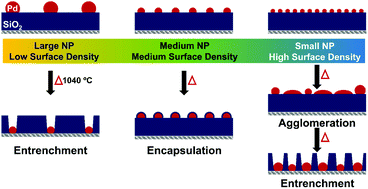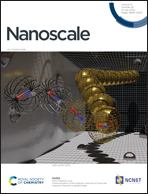Mapping the thermal entrenchment behavior of Pd nanoparticles on planar SiO2 supports†
Abstract
Thermal treatment of metal nanoparticles at temperatures above 1000 °C leads to the formation of nanopores in amorphous SiO2 planar supports. In this work, we employ Pd/SiO2 as a model system to investigate how the initial size and distribution of nanoparticles on the SiO2 surface affects the behavior of the nanoparticles at high temperatures with respect to the formation of nanopores and related structures. We also examine the role of physical processing parameters such as heating temperature, ramp rate, and heating time in altering the type, size, and number density of features formed. These studies reveal that nanopore formation competes with other surface phenomena, including nanoparticle agglomeration and encapsulation, which also occur at high temperatures. We establish that the dominant behavior, among the many competing phenomena occurring at the metal–oxide interface, depends on the initial surface distribution of the nanoparticles. Using this knowledge, we show that the final nanopore diameter and surface density are highly tunable.



 Please wait while we load your content...
Please wait while we load your content...